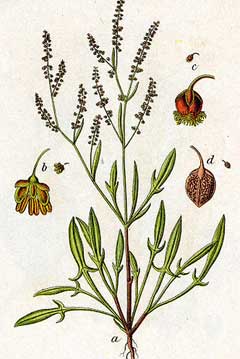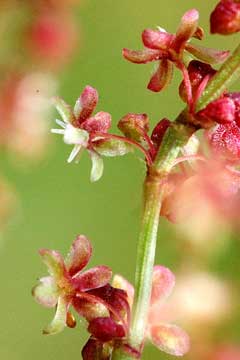 |
|
http://commons.wikimedia.org/wiki/File:Rumex_acetosella_Sturm58.jpg |
 |
| http://www.commanster.eu/commanster.html |
Translate this page:
Summary
Physical Characteristics

 Rumex acetosella is a PERENNIAL growing to 0.3 m (1ft) by 1 m (3ft 3in) at a fast rate.
Rumex acetosella is a PERENNIAL growing to 0.3 m (1ft) by 1 m (3ft 3in) at a fast rate.
See above for USDA hardiness. It is hardy to UK zone 5 and is not frost tender. It is in flower from May to August, and the seeds ripen from July to September. The species is dioecious (individual flowers are either male or female, but only one sex is to be found on any one plant so both male and female plants must be grown if seed is required). and is pollinated by Wind. The plant is not self-fertile.
It is noted for attracting wildlife.
Suitable for: light (sandy), medium (loamy) and heavy (clay) soils. Suitable pH: mildly acid, neutral and basic (mildly alkaline) soils and can grow in very acid soils.
It can grow in semi-shade (light woodland) or no shade. It prefers moist soil. The plant can tolerate maritime exposure.
UK Hardiness Map
US Hardiness Map
Synonyms
Plant Habitats
Meadow;
Edible Uses
Edible Parts: Leaves Root Seed
Edible Uses: Drink
Leaves - raw or cooked[4, 12, 55, 62, 183]. A delicious lemon-like flavour, most people consider them too strong to use in quantity, but they are excellent as a flavouring in mixed salads[K]. The leaves should only be used in small quantities due to the oxalic acid content. The leaves can be used as thickeners in soups etc[102], they can also be dried for later use[12]. Root - cooked. It can be dried, ground into a powder and made into noodles[105]. Seed - raw or cooked[172]. Easy to harvest, but the seed is rather small and fiddly to use[K]. A drink similar to lemonade (but without the fizz) is made by boiling up the leaves[102].
References More on Edible Uses
Medicinal Uses
Plants For A Future can not take any responsibility for any adverse effects from the use of plants. Always seek advice from a professional before using a plant medicinally.
Astringent Diuretic Poultice Urinary
Sheep's sorrel is a detoxifying herb, the fresh juice of the leaves having a pronounced diuretic effect[254]. Like other members of the genus, it is mildly laxative and holds out potential as a long term treatment for chronic disease, in particular that of the gastro-intestinal tract[254]. The plant is also part of a North American formula called essiac which is a popular treatment for cancer. Its effectiveness has never been reliably proven or disproven since controlled studies have not been carried out. The other herbs included in the formula are Arctium lappa, Ulmus rubra and Rheum palmatum[254]. The whole plant, used in the fresh state, is diaphoretic, diuretic and refrigerant[222]. A tea made from the leaves is used in the treatment of fevers, inflammation and scurvy[222]. The leaf juice is useful in the treatment of urinary and kidney diseases[4]. A leaf poultice is applied to tumours, cysts etc, and is a folk treatment for cancer[222]. A tea made from the roots is astringent and is used in the treatment of diarrhoea and excessive menstrual bleeding[222].
References More on Medicinal Uses
The Bookshop: Edible Plant Books
Our Latest books on Perennial Plants For Food Forests and Permaculture Gardens in paperback or digital formats.

Edible Tropical Plants
Food Forest Plants for Hotter Conditions: 250+ Plants For Tropical Food Forests & Permaculture Gardens.
More

Edible Temperate Plants
Plants for Your Food Forest: 500 Plants for Temperate Food Forests & Permaculture Gardens.
More

More Books
PFAF have eight books available in paperback and digital formats. Browse the shop for more information.
Shop Now
Other Uses
Dye
Dark green to brown and dark grey dyes can be obtained from the roots, they do not need a mordant[168]. A dynamic accumulator gathering minerals or nutrients from the soil and storing them in a more bioavailable form - used as fertilizer or to improve mulch.
Special Uses
Attracts Wildlife Dynamic accumulator Food Forest
References More on Other Uses
Cultivation details
Succeeds in most soils[37], preferring a moist moderately fertile well-drained soil in a sunny position[200]. Although a plant of acid soils, it can tolerate some alkalinity[17]. A good food plant for the caterpillars of many species of butterflies[24, 30], it grows well in the summer meadow[24]. Dioecious. Male and female plants must be grown if seed is required. For polyculture design as well as the above-ground architecture (form - tree, shrub etc. and size shown above) information on the habit and root pattern is also useful and given here if available. A clumping mat former. Forming a dense prostrate carpet spreading indefinitely [1-2]. The root pattern is stoloniferous rooting from creeping stems above the ground [1-2].
References Carbon Farming Information and Carbon Sequestration Information
Temperature Converter
Type a value in the Celsius field to convert the value to Fahrenheit:
Fahrenheit:
The PFAF Bookshop
Plants For A Future have a number of books available in paperback and digital form. Book titles include Edible Plants, Edible Perennials, Edible Trees,Edible Shrubs, Woodland Gardening, and Temperate Food Forest Plants. Our new book is Food Forest Plants For Hotter Conditions (Tropical and Sub-Tropical).
Shop Now
Plant Propagation
Seed - sow autumn or spring in situ. Division in spring.
Other Names
If available other names are mentioned here
Native Range
TEMPERATE ASIA: Altay, China, Ciscaucasia, Dagestan, Eastern Siberia, Far East, Fujian Sheng, Hebei Sheng, Heilongjiang Sheng, Henan Sheng, Hubei Sheng, Hunan Sheng, Jiangxi Sheng, Kazakhstan, Korea, Lebanon, Nei Mongol Zizhiqu, Russian Federation, Russian Federation, Russian Federation-Ciscaucasia, Russian Federation-Eastern Siberia, Russian Federation-Far East, Russian Federation-Western Siberia, Shandong Sheng, Sichuan Sheng, Syria, Taiwan, Turkey, Western Siberia, Xinjiang Uygur Zizhiqu, Yunnan Sheng, Zhejiang Sheng,Iran. TROPICAL ASIA: India , EUROPE: Denmark, Finland, United Kingdom (U.K.), Ireland, Norway, Svalbard and Jan Mayen, Sweden, Austria, Belgium, Switzerland, Czech Republic, Germany, Hungary, Netherlands, Poland, Slovakia, Russian Federation-European part, European part, Belarus, Estonia, Lithuania, Latvia, Moldova, Ukraine, Albania, Bulgaria, Bosnia and Herzegovina, Croatia, Italy (incl. Sardinia, Sicily), North Macedonia, Montenegro, Romania, Serbia, Slovenia, Spain, France (incl. Corsica), Portugal, AFRICA: Portugal, Azores, Algeria, Morocco.
Weed Potential
Right plant wrong place. We are currently updating this section.
Please note that a plant may be invasive in one area but may not in your area so it's worth checking.
Conservation Status
IUCN Red List of Threatened Plants Status :

Growth: S = slow M = medium F = fast. Soil: L = light (sandy) M = medium H = heavy (clay). pH: A = acid N = neutral B = basic (alkaline). Shade: F = full shade S = semi-shade N = no shade. Moisture: D = dry M = Moist We = wet Wa = water.
Now available:
Food Forest Plants for Mediterranean Conditions
350+ Perennial Plants For Mediterranean and Drier Food Forests and Permaculture Gardens.
[Paperback and eBook]
This is the third in Plants For A Future's series of plant guides for food forests tailored to
specific climate zones. Following volumes on temperate and tropical ecosystems, this book focuses
on species suited to Mediterranean conditions—regions with hot, dry summers and cool, wet winters,
often facing the added challenge of climate change.
Read More
Expert comment
Author
L.
Botanical References
17
Links / References
For a list of references used on this page please go here
Readers comment
© 2010, Plants For A Future. Plants For A Future is a charitable company limited by guarantee, registered in England and Wales. Charity No. 1057719, Company No. 3204567.